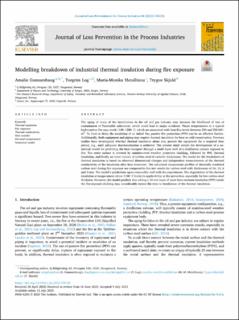| dc.contributor.author | Gunnarshaug, Amalie | |
| dc.contributor.author | Log, Torgrim | |
| dc.contributor.author | Log, Maria-Monika Metallinou | |
| dc.contributor.author | Skjold, Trygve | |
| dc.date.accessioned | 2023-09-13T10:52:43Z | |
| dc.date.available | 2023-09-13T10:52:43Z | |
| dc.date.created | 2023-08-09T19:33:27Z | |
| dc.date.issued | 2023 | |
| dc.identifier.citation | Journal of Loss Prevention in the Process Industries. 2023, 84 . | en_US |
| dc.identifier.issn | 0950-4230 | |
| dc.identifier.uri | https://hdl.handle.net/11250/3089127 | |
| dc.description.abstract | The aging of many of the installations in the oil and gas industry may increase the likelihood of loss of containment of flammable substances, which could lead to major accidents. Flame temperatures in a typical hydrocarbon fire may reach 1100–1200 °C, which are associated with heat flux levels between 250 and 350 kW/m2. To limit or delay the escalation of an initial fire, passive fire protection (PFP) can be an effective barrier. Additionally, both equipment and piping may require thermal insulation for heat or cold conservation. Previous studies have investigated whether thermal insulation alone may protect the equipment for a required time period, e.g., until adequate depressurization is achieved. The present study entails the development of a numerical model for predicting the heat transport through a multi-layer wall of a distillation column exposed to fire. The outer surface is covered by stainless-steel weather protective cladding, followed by PFP, thermal insulation, and finally an inner column of carbon steel of variable thicknesses. The model for the breakdown of thermal insulation is based on observed dimensional changes and independent measurements of the thermal conductivity of the insulation after heat treatment. The calculated temperature profiles of thermally insulated carbon steel during fire exposure are compared to fire test results for carbon steel with thicknesses of 16, 12, 6 and 3 mm. The model's predictions agree reasonably well with the experiments. The degradation of the thermal insulation at temperatures above 1100 °C limits its applicability as fire protection, especially for low carbon-steel thickness. However, the model predicts that adding a 10-mm layer of more heat-resistant insulation (PFP) inside the fire-exposed cladding may considerably extend the time to breakdown of the thermal insulation. | en_US |
| dc.language.iso | eng | en_US |
| dc.publisher | Elsevier | en_US |
| dc.rights | Navngivelse 4.0 Internasjonal | * |
| dc.rights.uri | http://creativecommons.org/licenses/by/4.0/deed.no | * |
| dc.title | Modelling breakdown of industrial thermal insulation during fire exposure | en_US |
| dc.type | Peer reviewed | en_US |
| dc.type | Journal article | en_US |
| dc.description.version | publishedVersion | en_US |
| dc.rights.holder | © 2023 The Authors | en_US |
| dc.source.pagenumber | 0 | en_US |
| dc.source.volume | 84 | en_US |
| dc.source.journal | Journal of Loss Prevention in the Process Industries | en_US |
| dc.identifier.doi | 10.1016/j.jlp.2023.105135 | |
| dc.identifier.cristin | 2165994 | |
| dc.source.articlenumber | 105135 | en_US |
| cristin.ispublished | true | |
| cristin.fulltext | original | |
| cristin.qualitycode | 1 | |

